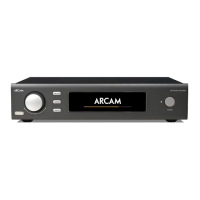EN-14
ST60 DAC Digital Filters
The ST60 allows the listener to choose between a
number of digital filters for use in the audio DAC.
Digital filters are required to minimise unwanted
antialiasing distortion in the audio band but no digital
filter is perfect, all are a compromise between various
parameters. These include:
Frequency response – Audio level with respect to
frequency. Ideally this should not vary significantly
between 20Hz and 20kHz.
Phase – The time delay introduced between
reproducing different frequencies within the pass band
of the filter. Ideally this would be as low as possible
(linear phase).
Pre ringing – Additional audio artefacts that precede
the original audio impulse. These are sometimes
thought to be bad as this phenomenon does not exist
in the natural world, so ideally this should be as low
level and last for as short a time as possible.
Post ringing – Additional audio artefacts that follow the
original audio impulse. Ideally these should be as low in
level and last for as short a time as possible.
Aliasing – Additional audio artefacts introduced into the
audio band from high frequency signals.
We have chosen our default filter through a
combination of careful measurement and listening
tests and we believe they are the best compromise to
achieve the best listening experience. However, all of
the filters sacrifice performance of one parameter to
improve another. Therefore, dependant on your choice
of listening material and personal preference, you may
wish to choose one of the other options. There is no
universal right or wrong choice
Note that any audible differences are most likely to be
heard with sample rates of 48kHz and below.
Hybrid Filters
Brick Wall
No phase shift, but introduces both pre and post
ringing artefacts.
Corrected Minimum Phase
Low pre-ringing and the phase response varies
at higher frequencies. There is more post ringing
compared with linear phase and apodizing filters.
Apodizing (default)
A compromise between phase, frequency response
and ringing. Its main advantage is that it removes most
of the ringing that has been introduced upstream in
the recording process when the original material was
recorded and mastered.
Minimum Phase Filters
Minimum Phase Slow Roll O
No pre-ringing artefacts but can introduce phase shifts
at higher frequencies. It has less post ringing than the
Minimum Phase Fast Roll Off, but this is still higher than
the linear phase filter options. Very high frequencies in
the last half octave of the filter pass band will be slightly
attenuated.
Minimum Phase Fast Roll O
No pre-ringing and the phase response varies at higher
frequencies. There are significantly higher amounts
of post ringing compared with the linear phase filter
options.
Linear Phase Filters
Linear Phase Slow Roll O
Low and equal levels of pre and post ringing. No phase
shifts but can introduce high frequency aliasing at a
higher level than linear phase fast roll off. Very high
frequencies will be slightly attenuated.
Linear Phase Fast Roll O
Higher and equal levels of pre and post ringing
compared with linear phase slow roll off. No phase
shifts and with minimal high frequency aliasing
compared with slow roll off.

